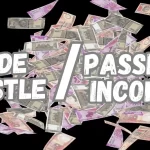A side hustle is indeed a great way to supplement your income and explore your passions. Whether you’re offering freelance services, selling handmade crafts, or creating digital products, it’s essential to find something that aligns with your interests and skills. Remember to manage your time effectively to balance your primary job and side hustle.

Let’s delve into the concept of a side hustle in more detail.
A side hustle is an additional income-generating activity that you pursue alongside your main job or occupation. Here are some key points to consider:
Purpose and Benefits:

- Supplemental Income: Side hustles allow you to earn extra money beyond your regular paycheck. This additional income can help you achieve financial goals, pay off debts, or build savings.
- Skill Development: Engaging in a side hustle provides an opportunity to develop new skills or enhance existing ones. Whether it’s freelance writing, graphic design, or tutoring, you’ll gain valuable experience.
- Diversification: Relying solely on one income source can be risky. A side hustle diversifies your income streams, making you less vulnerable to economic fluctuations or job instability.
Types of Side Hustles:

Freelancing: Offer your expertise as a freelancer in areas like writing, design, programming, or consulting. Platforms like Upwork, Fiverr, and Freelancer connect freelancers with clients.
Online Selling: Sell products through e-commerce platforms (e.g., Etsy, eBay, Amazon) or create your own online store. You can sell handmade crafts, vintage items, or digital products.
Service-Based Hustles: Provide services such as dog walking, house cleaning, virtual assistance, or personal training.
Gig Economy: Participate in gig work like driving for rideshare services (Uber, Lyft), food delivery (DoorDash, Grubhub), or participating in market research studies.
Passive Income Streams: Create passive income sources, such as affiliate marketing, rental properties, or investing in dividend-paying stocks.
Getting Started:

Identify Your Skills: Consider what skills or interests you can leverage. What are you good at? What do you enjoy doing?
Time Management: Assess how much time you can allocate to your side hustle. Be realistic about balancing it with your primary job and personal life.
Market Research: Research demand and competition for your chosen side hustle. Understand your target audience and pricing.
Legal Considerations: Depending on your location and type of hustle, you may need permits, licenses, or tax registrations.
Challenges:
Time Commitment: Side hustles require dedication. Balancing work, family, and personal time can be challenging.
Risk of Burnout: Be mindful of burnout. Ensure self-care and set boundaries.
Initial Investment: Some side hustles may require upfront costs (e.g., buying inventory, setting up a website).
Remember, a successful side hustle isn’t just about making money—it’s also about personal growth, learning, and enjoying the journey. Choose something that aligns with your interests and goals! 😊🌟
Let’s dive into popular side hustles, effective time management tips, and inspiring success stories:
What are some popular side hustles?
Popular Side Hustles:
- Freelancing: Offer your skills (e.g., writing, design, programming) on platforms like Upwork or Fiverr.
- Online Selling: Sell products on platforms like Etsy, eBay, or Amazon.
- Service-Based Hustles: Provide services like dog walking, virtual assistance, or tutoring.
- Passive Income Streams: Explore affiliate marketing, rental properties, or dividend stocks.
- Content Creation: Start a YouTube channel, blog, or podcast.
How to manage your time effectively with a side hustle?
Time Management Tips for Side Hustles:
- Set Dedicated Time: Allocate specific blocks for your side hustle in your calendar.
- Start Small: Commit to at least one hour per week initially. Push through the first 10-15 minutes.
- Prioritize Tasks: Focus on high-impact activities and set your own deadlines.
- Outsource When Possible: Delegate tasks to save time.
Share success stories of people with side hustles?
Inspiring Success Stories:
- Ryan Kaji (Ryan ToysReview): Started as a toddler unboxing toys on YouTube. Now has a net worth over $30 million.
- Jason Saddler (I Wear Your Shirt): Earned over $1 million by wearing t-shirts on camera.
- Alex Tew (The Million Dollar Homepage): Created a website where people bought ad space for $1 per pixel, earning him $1 million.
- Joel Young (Jump Start Video): Turned video editing skills into a profitable side hustle.
Remember, consistency and determination can turn your passion project into a successful venture! 😊🚀
How to find clients for your freelance side hustle?
Finding Clients for Your Freelance Side Hustle:
Freelance Job Boards: Platforms like Upwork, Fiverr, and Freelancer.com are excellent places to connect with potential clients. Create a compelling profile, showcase your skills, and actively bid on relevant projects.
LinkedIn: Be active on LinkedIn, connect with other professionals, and share your expertise. Networking can lead to client referrals.
Facebook Groups: Join relevant groups related to your niche. Engage with members and offer your services.
Twitter and Instagram: Follow and engage with potential clients. Share your work and expertise.
Personal Website or Portfolio: Create a professional website highlighting your skills and experience. Use it to attract clients and showcase your work.
What are some common mistakes to avoid in side hustles?
Common Mistakes to Avoid in Side Hustles:
High Startup Costs: Choose side hustles that require minimal upfront investment to avoid unnecessary stress.
Ignoring Marketing Efforts: Allocate time for marketing and sales. Stand out among competitors by promoting your services.
Charging Too Little: Price your services appropriately based on your expertise. Don’t undervalue your time and skills.
Overworking: Balance your side hustle with other commitments. Avoid burnout by setting boundaries.
Choosing Unenjoyable Hustles: Pursue something you love to prevent it from feeling like a chore.
Remember, thoughtful planning and avoiding these pitfalls can lead to a successful and fulfilling side hustle! 😊🚀
How to create an effective portfolio?
Creating an Effective Portfolio:
1. Be Thoughtful About What You Include:
- Curate your portfolio by showcasing your best work. Include pieces that reflect your skills and the type of projects you want to attract.
2. Showcase Your Most Unique and Creative Work:
- Highlight projects that stand out and demonstrate your creativity.
3. Go for Variety:
- Include diverse pieces to showcase your range of skills and interests.
4. Stay Current:
- Regularly update your portfolio with new work.
5. Include Professional Photography:
- High-quality images enhance the presentation of your work.
6. Make It Interesting:
- Use a clean, easy-to-navigate design that keeps viewers engaged.
7. Showcase the Design Process:
- Explain your thought process, problem-solving, and execution.
What are some negotiation tips for freelancers?
Negotiation Tips for Freelancers:
1. Communicate Value:
- Explain the value you provide before negotiating rates.
2. Determine Your Minimum Acceptable Rate (MAR):
- Know your bottom line.
3. Quote Higher Than Your Standard Rate:
- Leave room for negotiation.
4. Learn to Say ‘No’:
- Don’t compromise your value.
5. Offer a Small Discount Initially:
- Build rapport with new clients.
6. Define Clear Scope and Deliverables:
- Avoid misunderstandings later on.























When I originally commented I clicked the -Notify me when new comments are added- checkbox and now each time a comment is added I get four emails with the same comment. Is there any way you can remove me from that service? Thanks!
Good post and straight to the point. I am not sure if this is really the best place to ask but do you people have any ideea where to employ some professional writers? Thank you 🙂
F*ckin¦ amazing things here. I¦m very glad to look your article. Thanks so much and i am taking a look forward to contact you. Will you please drop me a mail?
My programmer is trying to persuade me to move to .net from PHP. I have always disliked the idea because of the expenses. But he’s tryiong none the less. I’ve been using WordPress on numerous websites for about a year and am nervous about switching to another platform. I have heard fantastic things about blogengine.net. Is there a way I can transfer all my wordpress posts into it? Any help would be really appreciated!
I really enjoy looking at on this web site, it has excellent blog posts.
I do accept as true with all of the ideas you have offered for your post. They’re really convincing and will definitely work. Nonetheless, the posts are too short for starters. May just you please prolong them a little from next time? Thanks for the post.
Hey there, You’ve done an incredible job. I will certainly digg it and personally suggest to my friends. I am confident they will be benefited from this site.
Thank you for sharing with us, I believe this website genuinely stands out : D.
Your articles are both relatable and informative.
Your insights are enlightening.